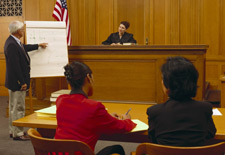Home | Glossary | Resources | Help | Contact Us | Course Map
Archival Notice
This is an archive page that is no longer being updated. It may contain outdated information and links may no longer function as originally intended.
Courtroom Testimony
All forensic sciences today are rigorously tested and documented. When scientific information is presented in court, judges, attorneys, and examiners alike struggle to understand or effectively present the technology. Prosecutors and defense attorneys with large caseloads and severe time constraints wrestle to comprehend even the basic concepts. Prosecution and defense bars spend countless dollars attending training seminars on how to handle technical evidence.
Effective courtroom testimony is a critical component of the examiners duties. The ability to effectively communicate an understanding of the science, technology, and test analyses involved with a particular case to non-scientists is essential. Maintaining objectivity, professionalism, and scientific integrity is absolutely necessary and will avoid many of the pitfalls that examiners may otherwise face.
| Important Notice: |
| The laws, rules of evidence, and rules of procedure may vary from court to court and state to state. The examiner should always check with an attorney (normally the prosecuting attorney) before giving testimony to be aware of the particular law and rules applicable in the jurisdiction. The content of this module is not intended, nor should it be construed, as legal advice. |
Criminal Proceedings
Generally, there are four types of court within the criminal justice system:
- Grand Jury (not a true court type, but a proceeding where witnesses testify)
- Trial Court
- Appellate Court
- Supreme Court
There may be times when examiners are called to testify in Grand Jury and Trial Court proceedings. The Grand Jury is a panel of citizens subpoenaed as any other jury for the particular purpose of hearing evidence presented by the prosecuting attorneys office only. Grand Jurors may be permitted to ask questions of witnesses who are invited to testify before the Grand Jury. There is normally no defendant or defense counsel present during these proceedings. States which do not use grand juries rely instead upon preliminary hearings. A preliminary hearing is held in order to determine whether there is probable cause to hold the defendant for trial. A few states use both the grand jury mechanism and a preliminary hearing. The preliminary hearing will have many of the same characteristics as a criminal trial. The defendant may be present, and the prosecution may present witnesses and will offer evidence in support of the complaint. The defendant will be afforded the right to testify and may also call witnesses.
Examiners will spend most of their testimony time in the Trial Court, where they may encounter one of two types of proceedings: the motion hearing or the trial. A motion proceeding is normally comprised of the judge, court personnel, prosecuting attorney, defense attorney, and defendant. The trial is comprised of the same individuals as the motion hearing with a jury present. Examiners are not typically called to testify at appellate or supreme court hearings.
Additional Online Courses
- What Every First Responding Officer Should Know About DNA Evidence
- Collecting DNA Evidence at Property Crime Scenes
- DNA – A Prosecutor’s Practice Notebook
- Crime Scene and DNA Basics
- Laboratory Safety Programs
- DNA Amplification
- Population Genetics and Statistics
- Non-STR DNA Markers: SNPs, Y-STRs, LCN and mtDNA
- Firearms Examiner Training
- Forensic DNA Education for Law Enforcement Decisionmakers
- What Every Investigator and Evidence Technician Should Know About DNA Evidence
- Principles of Forensic DNA for Officers of the Court
- Law 101: Legal Guide for the Forensic Expert
- Laboratory Orientation and Testing of Body Fluids and Tissues
- DNA Extraction and Quantitation
- STR Data Analysis and Interpretation
- Communication Skills, Report Writing, and Courtroom Testimony
- Español for Law Enforcement
- Amplified DNA Product Separation for Forensic Analysts


